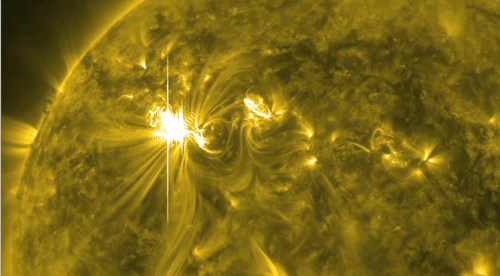\r\n
\r\nThe brunt of the storm is expected to strike early Thursday and last through Friday, possibly garbling some of Earthlings' most prized gadgets but also giving viewers in parts of Central Asia a prime look at the aurora borealis, or northern lights, when darkness falls on Thursday.
\r\n
\r\n"Space weather has gotten very interesting over the past 24 hours," said Joseph Kunches, a space weather scientist with the National Oceanic and Atmospheric Administration (NOAA), on Wednesday.
\r\n
\r\nMeanwhile, NASA warned of a "severe" storm event that would impact both the Earth and Mars as well as some key space agency satellites.
\r\n
\r\nThe fuss began late Sunday at an active region on the Sun known as 1429, with a big solar flare that was associated with a burst of solar wind and plasma known as a coronal mass ejection that thrust toward the Earth at some four million miles per hour (6.4 million kilometers per hour).
\r\n
\r\nA pair of solar flares and a CME followed overnight Tuesday-Wednesday, setting off a strong geomagnetic and solar radiation storm registering at level three on a five-step scale.
\r\n
\r\nNASA said the first of the two flares on March 6-7 -- classified in the potent X class and facing directly at the Earth -- was the biggest this year and one of the largest of this cycle known as the solar minimum, which began in early 2007.
\r\n
\r\nIn fact, it was second only to a stronger one that erupted in August, and the leading edge of the CME it sparked is expected to reach Earth at 0525 GMT on March 8, plus or minus seven hours.
\r\n
\r\n"Such a CME could result in a severe geomagnetic storm, causing aurora at low latitudes, with possible disruption to high frequency radio communication, global positioning systems (GPS) and power grids," NASA said.
\r\n
\r\nThe solar flares alone caused brief high frequency radio blackouts that have now passed, according to NOAA.
\r\n
\r\nThe storm is likely "the strongest one since December 2006," Kunches said, noting, however, that the Earth experienced a stronger radio blackout last August.
\r\n
\r\n"But en masse, if you put it all together with the geomagnetic effects and the solar radiation effects, I would put it on par with one at the end of the last solar cycle, which was over five years ago."
\r\n
\r\nSatellites, power grids and even astronauts aboard the International Space Station could be affected by the radiation storm, which may cause them to seek shelter in better protected parts of the orbiting lab as they have in the past.
\r\n
\r\n"Flight surgeons in Houston's mission control center have been monitoring the solar activity and will continue to do so," NASA spokesman Mike Curie said.
\r\n
\r\n"They have determined that there presently is no concern for the six crew members aboard the International Space Station."
\r\n
\r\nHowever, Kunches said some commercial airlines have already taken actions to reroute and fly further away from the poles.
\r\n
\r\nAnd more such storms could follow in the coming days because region 1429 is expected to stay active, he said.
\r\n
\r\nGeomagnetic and radiation storms are growing more frequent as the Sun leaves its solar minimum period and moves into a solar maximum over the coming years, but people are generally protected by Earth's magnetic field.
\r\n
\r\n"The current increase in the number of X-class flares is part of the Sun's normal 11-year solar cycle, during which activity on the Sun ramps up to solar maximum, which is expected to peak in late 2013," the US space agency said.
\r\n
\r\nHowever, some experts are concerned that because the world is more reliant on GPS and satellite technology now than it was during the last solar maximum, more disruptions to modern life are likely.
\r\n
\r\nSpace storms are not new. The first major solar flare was recorded by British astronomer Richard Carrington in 1859.
\r\n
\r\nOther solar geomagnetic storms have been observed in recent decades. One huge solar flare in 1972 cut off long-distance telephone communication in the midwestern state of Illinois, NASA said.
\r\n
\r\nAnother similar flare in 1989 "provoked geomagnetic storms that disrupted electric power transmission" and caused blackouts across the Canadian province of Quebec, according to the US space agency said.(AFP)
\r\n
<한글 기사>
\r\n
\r\n강력 태양폭풍, 지구 전자기망 교란 전망
\r\n
\r\n지난 5년 사이 최대의 태양 폭풍이 일어나 이르면 8 일 오후 3시(한국시간)부터 지구의 송전망이나 위성통신위치확인시스템(GPS) 등 각 종 전자기망과 항공 교통이 크게 교란될 수 있다고 미국 당국이 밝혔다.
\r\n
\r\n미국 우주환경예측센터(SWPC)는 태양 표면에서 미국시간으로 6일 밤 두드러진 폭발이 일어났으며 이로 인한 태양폭풍이 9일까지 계속될 수 있다고 전망했다.
\r\n
\r\n전문가들은 이번 태양폭풍으로 중앙아시아의 일부 지역에서는 북극권에서나 볼 수 있는 오로라를 8일 밤에 볼 수도 있을 것이라고 밝혔다.
\r\n
\r\n일부 항공사들은 이미 이 기간에 북극권을 통과하는 항공편의 항로를 일부 변경 했다.
\r\n
\r\n미국해양대기국의 전문가 조 쿤치스는 이번 태양폭풍이 지구를 강타할 것이라고 말했다.
\r\n
\r\n그는 지구가 지난해 8월에 심각한 통신망 두절 현상을 겪었지만 이번 태양 폭풍 이 2006년 12월의 태양 폭풍 이후 가장 강력한 것이 될 수 있다고 예상했다.








![[Today’s K-pop] Blackpink’s Jennie, Lisa invited to Coachella as solo acts](http://res.heraldm.com/phpwas/restmb_idxmake.php?idx=644&simg=/content/image/2024/11/21/20241121050099_0.jpg)